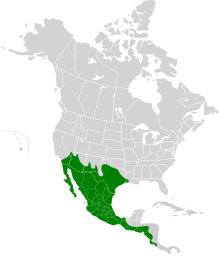| Inca dove | |
|---|---|

| |
| Conservation status | |
 Least Concern (IUCN 3.1) | |
| Scientific classification | |
| Domain: | Eukaryota |
| Kingdom: | Animalia |
| Phylum: | Chordata |
| Class: | Aves |
| Order: | Columbiformes |
| Family: | Columbidae |
| Genus: | Columbina |
| Species: | C. inca |
| Binomial name | |
| Columbina inca (Lesson, 1847) | |

| |
| Synonyms | |
|
Scardafella inca | |
The Inca dove or Mexican dove (Columbina inca) is a small New World dove. The species was first described by French surgeon and naturalist René Lesson in 1847. It reaches a length of 16.5–23 cm (6.5–9.1 in) and weighs 30–58 g (1.1–2.0 oz). The Inca dove has an average wingspan of 28.5 cm and a max wingspan of 32 cm. It is a slender species, with a gray-brown body covered in feathers that resemble a scaled pattern. The tail is long and square and edged with white feathers that may flare out in flight. The underwings are reddish, like other ground doves, and upon takeoff, the wings produce a distinctive, quiet rattling noise.
Distribution and habitat

The Inca dove ranges from Costa Rica in the south to the American Southwest in the north and is often common to abundant in suitable habitat. Its range has been expanding northward and southward the past few decades. Despite being named after the Inca Empire, this species does not occur in any of the lands that once constituted that empire. Inca doves are expanding their range in the north and south. This terrestrial species forms flocks in deserts, scrublands and cultivated areas and may also be found in urban settings where they feed upon grass seeds and take advantage of the ready availability of water from agricultural and suburban irrigation.
The Inca dove has escaped or been deliberately released in the US state of Florida, but there is no evidence that the population is breeding and may only persist due to continuing releases or escapes.
Nesting
Inca doves build their nests primarily in trees and shrubs. The average diameter is about 5 centimeters. The male gathers nesting material and presents it to the female, who also gathers some nesting material. The nest is composed of twigs, grass, weed stalks, and leaves and becomes reinforced with the brood's excrement. The nest is often used over and over.
Behavior

During winter, Inca doves roost in communal huddles, in a pyramid formation that aids in body-heat retention. These pyramids can contain 10 or more birds. They often flock outside of their territories, with flocks growing up to 100 birds-strong.
Voice
The song, a forceful cooing rendered variously as cowl-coo, POO-pup, or NO-hope, may be given from a tree, wire, or other open, high perch such as a television aerial.
References
- BirdLife International (2016). "Columbina inca". IUCN Red List of Threatened Species. 2016: e.T22690762A93287355. doi:10.2305/IUCN.UK.2016-3.RLTS.T22690762A93287355.en. Retrieved 13 November 2021.
- "Inca dove". All About Birds. Cornell Lab of Ornithology.
- Gatchell, Janae. "Columbina inca (Inca dove)". Animal Diversity Web. Retrieved 2020-09-27.
- Kannan, R. J. L. Jackson, and E. Brooks. 2019. History and Current Status of the Inca Dove (Columbina inca) in Arkansas. J. Arkansas Academy of Science 73: 65–71.|https://scholarworks.uark.edu/cgi/viewcontent.cgi?article=3343&context=jaas
- Mueller, Allan; Mueller, Allan J. (2004). Alan Poole (ed.). "Inca Dove (Columbina inca)". The Birds of North America Online. Ithaca, NY: Cornell Lab of Ornithology. doi:10.2173/bna.28. Retrieved 9 December 2012.
- Robertson, Paul B.; Schnapf, Ann F. (1987). "Pyramiding Behavior in the Inca Dove: Adaptive Aspects of Day-Night Differences" (PDF). The Condor. 89 (1). Cooper Ornithological Society: 185–187. doi:10.2307/1368776. JSTOR 1368776.
- Sibley, David (2003). The Sibley Field Guide to Birds of Western North America. Knopf. ISBN 0-679-45121-8.
- Stiles, F. Gary; Skutch, Alexander F. (1989). A Guide to the Birds of Costa Rica. Comstock Publishing Associates. ISBN 0-8014-9600-4.
- "Columbina inca". Integrated Taxonomic Information System. Retrieved 4 February 2006.
External links
- Inca dove - Columbina inca - USGS Patuxent Bird Identification InfoCenter
- Inca dove photo gallery at VIREO (Drexel University)
- "Inca dove media". Internet Bird Collection.
- Inca dove species account at Neotropical Birds (Cornell Lab of Ornithology)
- Interactive range map of Columbina inca at IUCN Red List maps